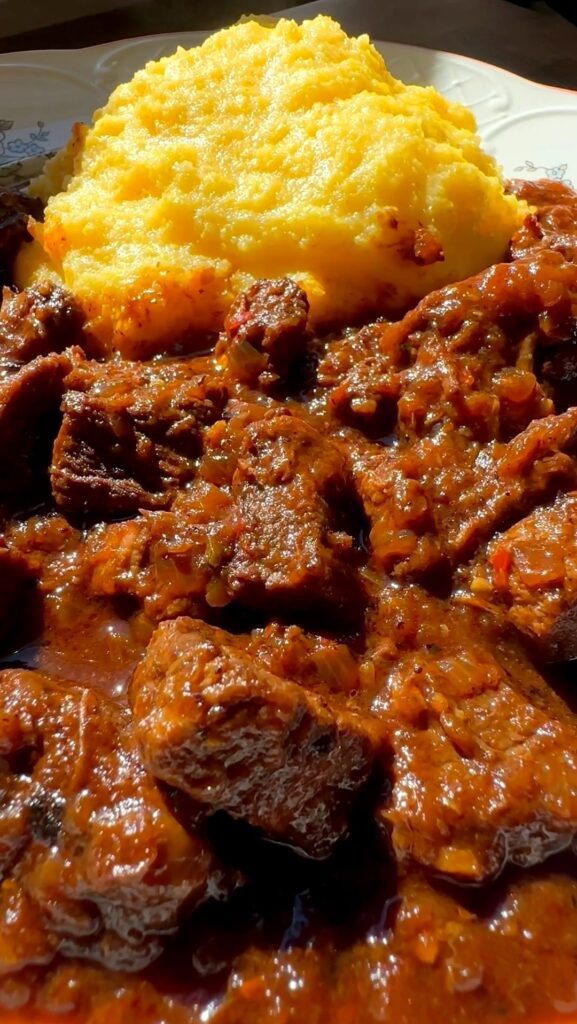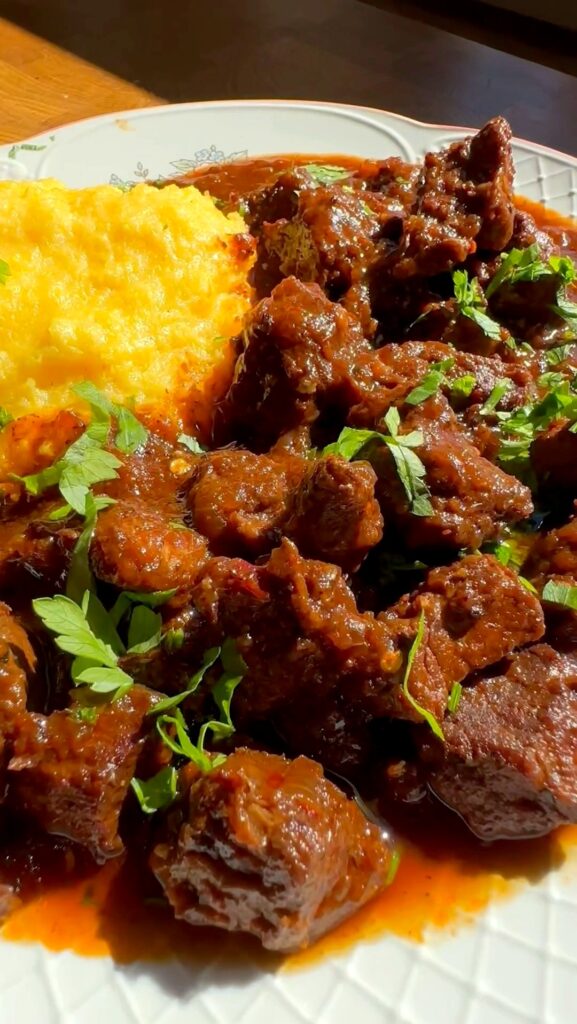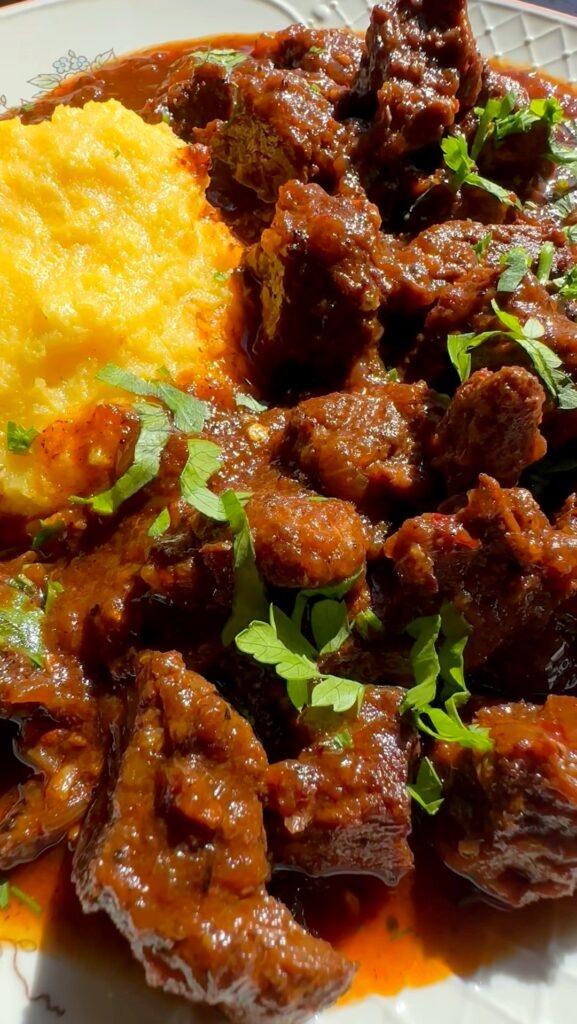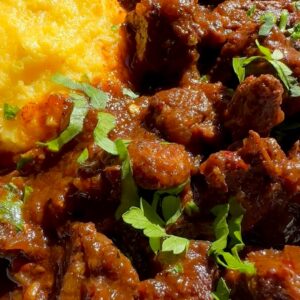This post may contain affiliate links. Please read our disclosure policy
There’s nothing quite like a warm bowl of Slow-Cooked Beef Goulash to bring comfort and flavor to the table. This recipe, inspired by the classic Hungarian stew, combines tender beef, rich spices, and slow-simmered ingredients for a meal that’s as satisfying as it is flavorful. Perfect for a chilly day or any time you’re craving a savory, homemade meal, this goulash is all about deep, developed flavors that come together with patience and love.
Why You’ll Love This Slow-Cooked Beef Goulash
Beef Goulash is a comforting one-pot dish that offers a beautiful balance of spices and hearty ingredients. With simple prep and hands-off cooking, it’s a wonderful dish to prepare on a relaxing afternoon. The magic happens as it simmers, filling your home with mouthwatering aromas and resulting in tender beef and a sauce rich in flavor. The mix of onions, garlic, sweet paprika, and a touch of red wine gives this goulash a unique depth that makes it unforgettable.
Ingredient Notes for Slow-Cooked Beef Goulash
- Beef: Use a well-marbled cut like chuck roast, brisket, or stewing beef. Cut into 1-2 inch cubes for even cooking.
- Onions: Yellow onions are preferred for their sweetness and depth of flavor. Chop finely to blend well with the stew.
- Garlic: Fresh garlic is best. Mince finely to release maximum flavor.
- Lard: Traditional choice for rich flavor; substitute with vegetable oil or olive oil if desired.
- Tomato Paste: Use high-quality paste for richness and to help thicken the stew.
- Red Wine: Choose a dry red wine you enjoy drinking; it will enhance the flavor. Substitute with additional beef broth if preferred.
- Beef Broth: Low-sodium broth is recommended to control saltiness. Homemade broth adds depth, but store-bought works well too.
- Spices:
- Sweet Paprika: Key flavor; use sweet or smoked paprika based on preference.
- Marjoram: Complements the beef; use fresh or dried.
- Cumin and Black Pepper: Adds warmth; adjust to taste.
- Bay Leaves: Provides aromatic quality; remove before serving.
- Salt: Adjust to taste at the end of cooking, especially if using pre-made broth or tomato paste.

How To Make Slow-Cooked Beef Goulash
Sear the Beef
Start by heating a large Dutch oven or heavy-bottomed pot over medium-high heat. Add a spoonful of lard or oil. Working in batches, sear the beef cubes on all sides until browned. This process enhances flavor and seals in the meat’s juices. Remove each batch of beef and set it aside.
Sauté Onions and Garlic
In the same pot, add a bit more lard if necessary. Lower the heat to medium and add the chopped onions, stirring frequently until they turn golden brown, about 8-10 minutes. Add the minced garlic and cook for another 1-2 minutes until fragrant.
Add Tomato Paste
Stir in the tomato paste, blending it well with the onions and garlic. Let it cook for 2-3 minutes to allow the paste to deepen in color and add a rich, concentrated flavor to the dish.
Deglaze with Red Wine
Pour in the red wine, using a wooden spoon to scrape up any browned bits from the bottom of the pot. Allow the wine to simmer and reduce for about 5 minutes, which will intensify its flavor and remove any raw alcohol taste.
Return Beef and Add Broth and Spices
Add the seared beef back into the pot, stirring to combine it with the wine mixture. Pour in the beef broth, then add the paprika, marjoram, cumin, black pepper, bay leaves, and a pinch of salt. Stir well to incorporate all ingredients, then bring the mixture to a gentle simmer.
Simmer to Perfection
Partially cover the pot, reduce the heat to low, and let the goulash simmer for at least 3 hours. The low and slow cooking process allows the beef to become incredibly tender, and the sauce will thicken and develop deep, savory flavors.
Season and Serve
Once the goulash has simmered to perfection, taste and adjust the seasoning as needed. Serve hot with your choice of side, like mashed potatoes, polenta, or rustic bread.

Tips for the Perfect Slow-Cooked Beef Goulash
- Brown in Batches: Avoid overcrowding the pan when searing beef. Searing in small batches allows each piece to develop a nice crust, which adds flavor to the final dish.
- Allow Wine to Reduce: When you add red wine, let it reduce for a few minutes before adding the broth. This helps concentrate the flavor and removes any raw taste.
- Low and Slow Cooking: For the most tender beef and richest flavor, keep the heat low and allow the stew to simmer slowly.
- Season at the End: As the flavors concentrate during cooking, you may need to adjust the salt and pepper just before serving.
Serving Suggestions
- Rustic Bread: Perfect for dipping and soaking up the rich sauce.
- Mashed Potatoes: Their creamy texture complements the hearty stew nicely.
- Egg Noodles or Spaetzle: Traditional accompaniments in Central European cuisine that make for a complete meal.
- Steamed Vegetables: Fresh green beans, carrots, or Brussels sprouts add brightness and balance to the plate.
- Polenta: Creamy polenta is an excellent base for goulash, providing a comforting texture that absorbs the flavorful sauce beautifully.
Storage
Refrigeration:
- Store any leftovers in an airtight container in the refrigerator for up to 3-4 days.
- Reheat on the stovetop over low heat until warmed through. You may need to add a splash of broth if the goulash has thickened too much.
Freezing:
- Beef Goulash freezes well for up to 3 months.
- Allow it to cool completely, then transfer to a freezer-safe container or portion into smaller containers for easy reheating.
- Thaw overnight in the refrigerator and reheat on the stovetop.

Frequently Asked Questions (FAQ)
1. Can I make Beef Goulash in advance?
Yes! Goulash often tastes better the next day as the flavors continue to develop. Simply store it in the refrigerator and reheat when ready to serve.
2. Can I substitute red wine?
If you prefer not to use wine, you can substitute it with an equal amount of additional beef broth. While red wine adds depth, the goulash will still be delicious without it.
3. What cuts of beef work best for goulash?
Chuck roast, brisket, or stewing beef are all excellent choices. These cuts become tender and flavorful with slow cooking.
4. Is this recipe gluten-free?
Yes, the goulash itself is gluten-free. Just ensure that any side dishes, like bread or noodles, are gluten-free if needed.
More Recipes You’ll Love
Roasted Chicken Thighs and Potatoes

Slow-Cooked Beef Goulash Recipe
Equipment
- Iron Dutch Oven Pot Ideal for searing the meat and slow-simmering the goulash.
- Sharp knife For chopping the beef, onions, and garlic.
- Cutting Board To prep ingredients safely and easily
- Spatula For stirring ingredients and scraping up browned bits from the pot
- Measuring Spoons For measuring out spices, tomato paste, wine, and broth.
- Tongs Handy for turning and removing the beef cubes as you sear them
- Ladle For serving the goulash
Ingredients
- 1,5 kg beef cut into cubes
- 800 g onions finely chopped
- 6 cloves garlic minced
- Lard (or oil, for frying)
- 4 tbsp tomato paste
- 250 ml red wine
- 1,5 L beef broth
Spices:
- 1 tbsp sweet paprika powder
- 1 tbsp marjoram
- 1 tsp cumin
- ½ tsp black pepper
- Salt, to taste
- Few bay leaves
Instructions
- Heat a large Dutch oven or heavy-bottomed pot over medium-high heat. Add a spoonful of lard or oil.
- Working in batches, sear the beef cubes on all sides until browned. Remove and set aside.
- In the same pot, add more lard if necessary. Lower the heat to medium and add the chopped onions. Sauté until golden brown (about 8-10 minutes).
- Add the minced garlic and cook for an additional 1-2 minutes until fragrant.
- Stir in the tomato paste, blending it well with the onions and garlic. Cook for 2-3 minutes to deepen the flavor.
- Pour in the red wine, scraping the browned bits from the bottom of the pot. Let it simmer for about 5 minutes to reduce.
- Return the seared beef to the pot, then add the beef broth. Incorporate the sweet paprika, marjoram, cumin, black pepper, bay leaves, and a pinch of salt. Stir to combine.
- Partially cover the pot and reduce the heat to low. Allow the goulash to simmer for at least 3 hours, stirring occasionally.
- After simmering, taste and adjust the seasoning as needed. Serve hot with your choice of side dishes, such as bread, mashed potatoes, or polenta. Enjoy!



